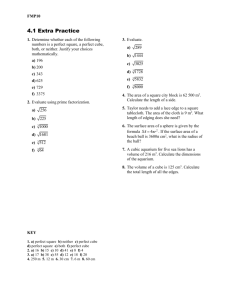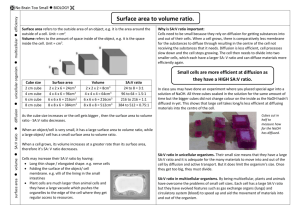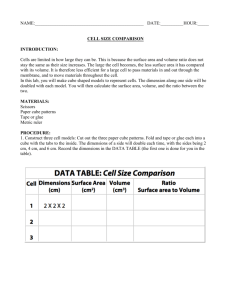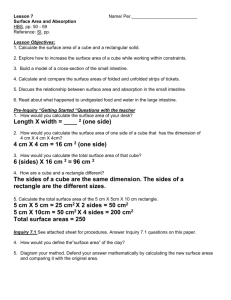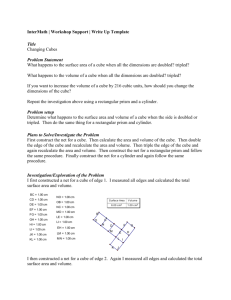Surface Area to Volume Ratio Tutorial
advertisement
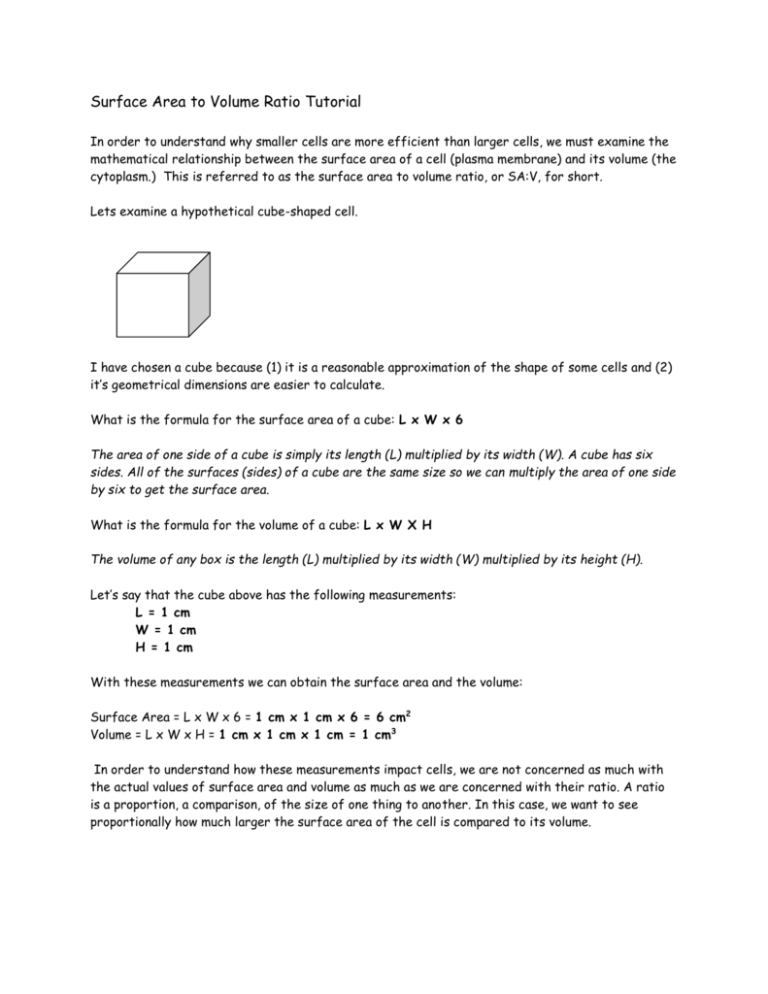
Surface Area to Volume Ratio Tutorial In order to understand why smaller cells are more efficient than larger cells, we must examine the mathematical relationship between the surface area of a cell (plasma membrane) and its volume (the cytoplasm.) This is referred to as the surface area to volume ratio, or SA:V, for short. Lets examine a hypothetical cube-shaped cell. I have chosen a cube because (1) it is a reasonable approximation of the shape of some cells and (2) it’s geometrical dimensions are easier to calculate. What is the formula for the surface area of a cube: L x W x 6 The area of one side of a cube is simply its length (L) multiplied by its width (W). A cube has six sides. All of the surfaces (sides) of a cube are the same size so we can multiply the area of one side by six to get the surface area. What is the formula for the volume of a cube: L x W X H The volume of any box is the length (L) multiplied by its width (W) multiplied by its height (H). Let’s say that the cube above has the following measurements: L = 1 cm W = 1 cm H = 1 cm With these measurements we can obtain the surface area and the volume: Surface Area = L x W x 6 = 1 cm x 1 cm x 6 = 6 cm2 Volume = L x W x H = 1 cm x 1 cm x 1 cm = 1 cm3 In order to understand how these measurements impact cells, we are not concerned as much with the actual values of surface area and volume as much as we are concerned with their ratio. A ratio is a proportion, a comparison, of the size of one thing to another. In this case, we want to see proportionally how much larger the surface area of the cell is compared to its volume. To write these values as a ratio, we simply put the values together like this: Surface Area : Volume SA : V Lets use the values we calculated for our hypothetical cell to find its surface area to volume ratio. SA : V 6 cm3 : 1 cm2 6: 1 Because this is simply a comparison and not a measurement, we can drop the units and simply write the ratio as 6 : 1. This means that for comparison purposes, the magnitude of the surface area is six times larger than the volume. Great! So what does it mean? Well … nothing, unless you compare it to the surface area to volume ratios of other cells. Calculate the surface area to volume ratios (SA : V) a cells that has a length, width, and height of 2 cm. Surface Area = L x W x 6 = 2 cm x 2 cm x 6 = 24 cm2 Volume = L x W x H = 2 cm x 2 cm x 2 cm = 8 cm3 Surface Area to Volume ratio (SA: V) = 24 : 8 Is 24 : 8 a bigger or smaller ratio than that of our first cell with a ratio of 6 : 1? To figure this out, it might be helpful to simply the ratio. Dividing both numbers in the ratio by the volume will make the volume number “1.” This will make it easier to compare. For instance: 24 : 8 8 8 = 3 : 1 You can see that 6 : 1 is a larger ratio than 3 : 1. What does this mean? It means that the second cell has a smaller surface area compared to its volume than the first cell. If you continue to make the cell larger, you would notice that the ratios continue to decrease. If you remember that the surface area, the plasma membrane, of the cell is critical to bringing in nutrients and expelling wastes from the cell, then you realize that a smaller ratio is more efficient for the cell. In other words, a smaller cell is more efficient than a larger cell! Surface Area to Volume Ratio Practice 1. Examine the cubes provided. There are six colors (pink, orange, yellow, green, blue and gray). 2. Make a hypothesis about which cube will have the highest surface area to volume ratio. Which will have the smallest SA:V ratio? 3. Rank each colored cube in order of greatest surface area to volume ratio down to smallest surface area to volume ratio in the Cube Color column of the chart below. 4. Each lab group should select ONE of the cubes and using a ruler, determine its surface area and volume. SURFACE AREA: VOLUME: 5. Calculate your cube's surface area to volume ratio (SA:V). 6. Place the information you calculated in #4 and #5 into the chart below. 7. Obtain the information for the remaining colored cubes from other groups. Complete your chart. 8. Were the rankings you made in #3 correct? Why or why not? Cube Color Surface Area Volume SA:V Ratio Size Largest Smallest




